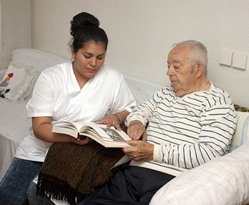How to Choose an Accredited RN Training Program near Sterling Utah
 Searching for the right nursing school near Sterling UT may feel like a difficult project, particularly if you aren’t sure what to search for in a good degree program. As you may already know, to practice as a registered nurse, you need to obtain the necessary education and training in order to become licensed. So it is vitally important that you study and assess the qualifications of each school you are considering before enrolling in your final selection. Unfortunately, too many potential students base their selection exclusively on the cost of tuition and the proximity of the school. Deciding on the least costly college or the one that is closest to your home is undoubtedly not the best way to choose a nursing program. There are many crucial additional aspects to look into before you determine where to enroll in classes. But before we examine that checklist, let’s first look at the nursing degree choices that are offered as well as what the functions of nurses are in our healthcare system.
Searching for the right nursing school near Sterling UT may feel like a difficult project, particularly if you aren’t sure what to search for in a good degree program. As you may already know, to practice as a registered nurse, you need to obtain the necessary education and training in order to become licensed. So it is vitally important that you study and assess the qualifications of each school you are considering before enrolling in your final selection. Unfortunately, too many potential students base their selection exclusively on the cost of tuition and the proximity of the school. Deciding on the least costly college or the one that is closest to your home is undoubtedly not the best way to choose a nursing program. There are many crucial additional aspects to look into before you determine where to enroll in classes. But before we examine that checklist, let’s first look at the nursing degree choices that are offered as well as what the functions of nurses are in our healthcare system.
Request Free Information on Nursing Schools Below
Nursing Degrees
There is more than one degree option offered to become a nurse. And in order to become a Registered Nurse (RN), a student must attend an accredited school and program. A nursing student can acquire a qualifying degree in as little as 2 years, or continue on to obtain a graduate degree for a total of six years. Following are some brief explanations of the nursing degrees that are offered to aspiring students in the Sterling UT area.
- Associates Degree. The Associate Degree in Nursing (ADN) is commonly a 2 year program made available by community colleges. It readies graduates for an entry level job in nursing in medical facilities including hospitals, clinics or nursing homes. Many employ the ADN as an entry into nursing and afterwards attain a more advanced degree.
- Bachelor’s Degree. The Bachelor of Science in Nursing (BSN) provides more comprehensive training than the ADN. It is typically a four year program offered at colleges and universities. Licensed RNs may be able to complete an accelerated program based on their prior training or degree and professional experience (RN to BSN). Those applying to the program may want to advance to a clinical or administrative position, or be more competitive in the employment market.
- Master’s Degree. The Master of Science in Nursing (MSN) is typically a 2 year program after achieving the BSN. The MSN program offers specialization training, for example to become a nurse practitioner or focus on administration, management or teaching.
After a graduating student has earned one of the above degrees, he or she must pass the National Council Licensure Examination for Registered Nurses (NCLEX-RN) so as to become licensed. Further requirements for licensing change from state to state, so don’t forget to get in touch with the Utah board of nursing for any state requirements.
Click Here to Get Free Information on Nursing Schools Near You!
Why Choose the Nursing Profession?
 Nurses are an indispensable part of a Sterling UT medical team, and for many patients, their primary care providers. A career in nursing can lead to many opportunities, such as healthcare education, research and specialty areas of practice. Nurses enter the profession for various reasons, the most notable are its practical and personal rewards. Nurses provide personal, one-on-one care to patients. Most individuals in a medical facility or home care environment have more contact with nurses than with physicians. Nurses often go into the profession due to a passion to tend to the needs of patients, including in situations of short-term treatment of illness and long-term care of chronic ailments. This humanistic aspect of the medical profession, as opposed to the research or analytical related aspects, is appealing to many who decide to enter into a nursing career. Nurses have a wide range of applicable skills and can select from an assortment of work settings, such as nursing homes, physician’s offices, health clinics, community centers and hospitals. Also, nurses can progress into a number of specializations, such as addictions, critical care, genetics and neonatology. While many nurses provide personal patient care, others opt to be teachers, policy consultants and pharmaceutical representatives.
Nurses are an indispensable part of a Sterling UT medical team, and for many patients, their primary care providers. A career in nursing can lead to many opportunities, such as healthcare education, research and specialty areas of practice. Nurses enter the profession for various reasons, the most notable are its practical and personal rewards. Nurses provide personal, one-on-one care to patients. Most individuals in a medical facility or home care environment have more contact with nurses than with physicians. Nurses often go into the profession due to a passion to tend to the needs of patients, including in situations of short-term treatment of illness and long-term care of chronic ailments. This humanistic aspect of the medical profession, as opposed to the research or analytical related aspects, is appealing to many who decide to enter into a nursing career. Nurses have a wide range of applicable skills and can select from an assortment of work settings, such as nursing homes, physician’s offices, health clinics, community centers and hospitals. Also, nurses can progress into a number of specializations, such as addictions, critical care, genetics and neonatology. While many nurses provide personal patient care, others opt to be teachers, policy consultants and pharmaceutical representatives.
Registered Nurse Job Functions
 Registered nurses are the primary occupation in the healthcare delivery system. RNs practice in numerous different medical environments, such as Sterling UT hospitals, family practices, outpatient clinics, nursing homes and even schools. Their primary function is to support doctors in the treatment of their patients. Having said that, the specific duties of a registered nurse will be dependent on their job or specialization in addition to where they work. A few of the responsibilities of an RN may include:
Registered nurses are the primary occupation in the healthcare delivery system. RNs practice in numerous different medical environments, such as Sterling UT hospitals, family practices, outpatient clinics, nursing homes and even schools. Their primary function is to support doctors in the treatment of their patients. Having said that, the specific duties of a registered nurse will be dependent on their job or specialization in addition to where they work. A few of the responsibilities of an RN may include:
- Providing medications
- Observing patients
- Conducting physical examinations
- Managing care
- Supervising LPNs, LVNs and nurse aides
- Instructing patients and their families
- Managing health records and charts
Nurses with a more advanced degree may have more advanced job duties and accountabilities. Nurse practitioners (NP), as an example, must hold a Master’s Degree and generally work more independently than their RN counterparts. They can provide primary or specialty care services, prescribe medications, and diagnose and treat routine illnesses or injuries.
Online Nursing Classes
 Enrolling in nursing colleges online is becoming a more popular way to get instruction and acquire a nursing degree. Certain schools will require attending on campus for a component of the training, and nearly all programs call for a certain amount of clinical rotation hours conducted in a local healthcare center. But since the balance of the training can be accessed online, this method may be a more accommodating answer to finding the time to attend classes for many Sterling UT students. Pertaining to tuition, a number of online degree programs are cheaper than other on campus options. Even supplemental expenses such as for commuting and study materials can be minimized, helping to make education more economical. And a large number of online programs are accredited by organizations such as the Commission on Collegiate Nursing Education (CCNE) for BSN and MSN degrees. So if your work and family obligations have left you with limited time to work toward your academic goals, it could be that an online nursing program will make it easier to fit a degree into your hectic schedule.
Enrolling in nursing colleges online is becoming a more popular way to get instruction and acquire a nursing degree. Certain schools will require attending on campus for a component of the training, and nearly all programs call for a certain amount of clinical rotation hours conducted in a local healthcare center. But since the balance of the training can be accessed online, this method may be a more accommodating answer to finding the time to attend classes for many Sterling UT students. Pertaining to tuition, a number of online degree programs are cheaper than other on campus options. Even supplemental expenses such as for commuting and study materials can be minimized, helping to make education more economical. And a large number of online programs are accredited by organizations such as the Commission on Collegiate Nursing Education (CCNE) for BSN and MSN degrees. So if your work and family obligations have left you with limited time to work toward your academic goals, it could be that an online nursing program will make it easier to fit a degree into your hectic schedule.
What to Ask Nursing Degree Programs
 Now that you have decided on which nursing program to enroll in, as well as whether to attend your classes on campus near Sterling UT or on the internet, you can utilize the following guidelines to begin narrowing down your choices. As you no doubt are aware, there are many nursing schools and colleges within Utah and the United States. So it is essential to lower the number of schools to choose from to ensure that you will have a manageable list. As we already pointed out, the location of the school and the cost of tuition are most likely going to be the primary two things that you will look at. But as we also emphasized, they should not be your sole qualifiers. So before making your ultimate choice, use the following questions to evaluate how your pick compares to the other programs.
Now that you have decided on which nursing program to enroll in, as well as whether to attend your classes on campus near Sterling UT or on the internet, you can utilize the following guidelines to begin narrowing down your choices. As you no doubt are aware, there are many nursing schools and colleges within Utah and the United States. So it is essential to lower the number of schools to choose from to ensure that you will have a manageable list. As we already pointed out, the location of the school and the cost of tuition are most likely going to be the primary two things that you will look at. But as we also emphasized, they should not be your sole qualifiers. So before making your ultimate choice, use the following questions to evaluate how your pick compares to the other programs.
- Accreditation. It’s a good idea to make sure that the degree or certificate program as well as the school is accredited by a U.S. Department of Education recognized accrediting agency. In addition to helping ensure that you receive a premium education, it may assist in securing financial aid or student loans, which are frequently not offered in Sterling UT for non-accredited schools.
- Licensing Preparation. Licensing prerequisites for registered nurses vary from state to state. In all states, a passing score is needed on the National Council Licensure Examination (NCLEX-RN) in addition to graduation from an accredited school. Many states require a certain number of clinical hours be completed, as well as the passing of additional tests. It’s important that the school you are enrolled in not only delivers an exceptional education, but also prepares you to meet the minimum licensing requirements for Utah or the state where you will be working.
- Reputation. Look at online rating companies to see what the reviews are for each of the schools you are considering. Ask the accrediting agencies for their reviews also. Additionally, get in touch with the Utah school licensing authority to check out if there are any complaints or compliance issues. Finally, you can call some Sterling UT healthcare organizations you’re interested in working for after graduation and ask what their opinions are of the schools as well.
- Graduation and Job Placement Rates. Find out from the RN schools you are looking at what their graduation rates are as well as how long on average it takes students to complete their programs. A low graduation rate may be an indication that students were unhappy with the program and dropped out. It’s also imperative that the schools have high job placement rates. A high rate will not only substantiate that the school has a favorable reputation within the Sterling UT healthcare community, but that it also has the network of relationships to help students obtain a position.
- Internship Programs. The best way to acquire experience as a registered nurse is to work in a clinical environment. Essentially all nursing degree programs require a specified number of clinical hours be completed. Many states have minimum clinical hour requirements for licensing as well. Find out if the schools have a working relationship with Sterling UT hospitals, clinics or labs and help with the placement of students in internships.
Graduate Nursing Programs Sterling UT
Evening RN Schools Sterling Utah
Deciding on the right nursing college is arguably the most critical first step to starting a new career in the health care field. There are numerous factors that you should think about when picking a nursing school. These variables will be prioritized differently depending on your current career goals, lifestyle, and economic status. As we have emphasized within this content, it is important that you choose a nursing college and a degree program that are each accredited and have exceptional reputations within the medical community. You originally came to this website due to your interest in Evening RN Schools and wanting more information on the topic Low Cost Nursing Courses Online.. However, by using our list of qualifying questions, you will be able to create a short list of schools to choose from so that you can make your final selection. And with the appropriate degree and training, combined with your dedication and ambition to succeed, you can become a practicing nurse in Sterling UT.
More Utah Nursing Locations
Sterling, Utah
As of the census[1] of 2000, there were 235 people, 73 households, and 58 families residing in the town. The population density was 976.3 people per square mile (378.1/km²). There were 81 housing units at an average density of 336.5 per square mile (130.3/km²). The racial makeup of the town was 97.45% White, 1.28% Native American, 0.43% from other races, and 0.85% from two or more races. Hispanic or Latino of any race were 1.70% of the population.
There were 73 households out of which 45.2% had children under the age of 18 living with them, 60.3% were married couples living together, 11.0% had a female householder with no husband present, and 20.5% were non-families. 19.2% of all households were made up of individuals and 9.6% had someone living alone who was 65 years of age or older. The average household size was 3.22 and the average family size was 3.72.
In the town, the population was spread out with 37.0% under the age of 18, 10.6% from 18 to 24, 22.6% from 25 to 44, 18.7% from 45 to 64, and 11.1% who were 65 years of age or older. The median age was 28 years. For every 100 females, there were 95.8 males. For every 100 females age 18 and over, there were 89.7 males.
